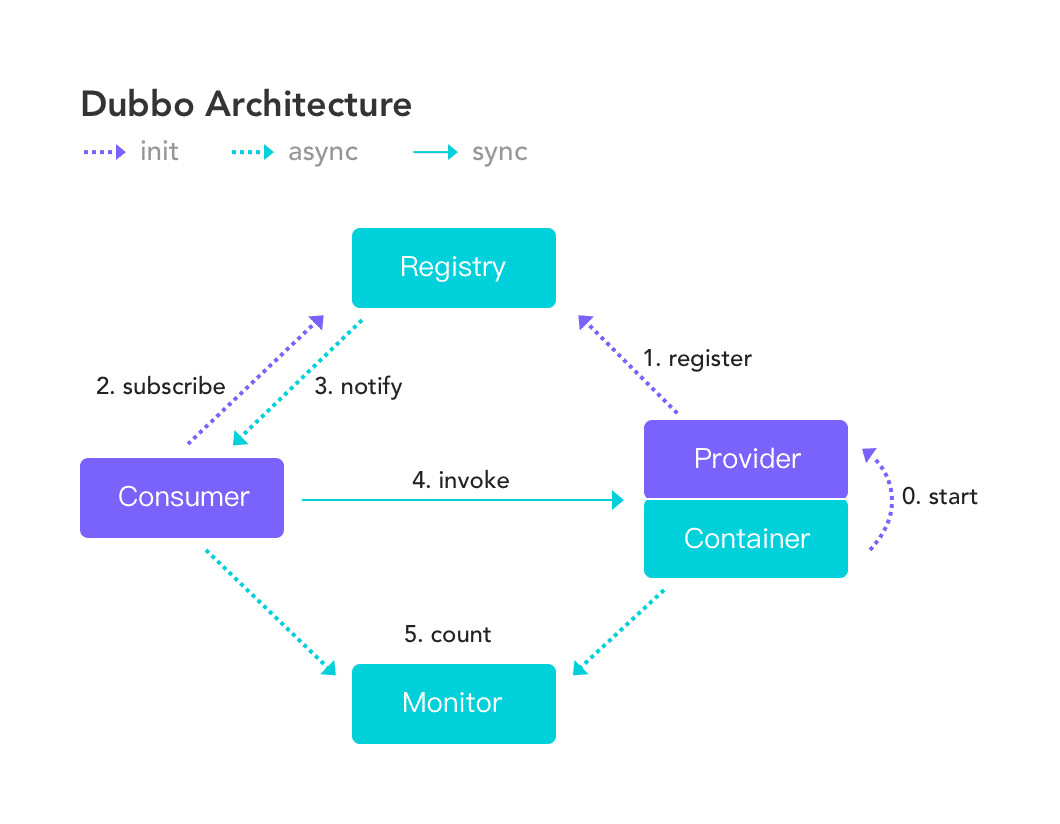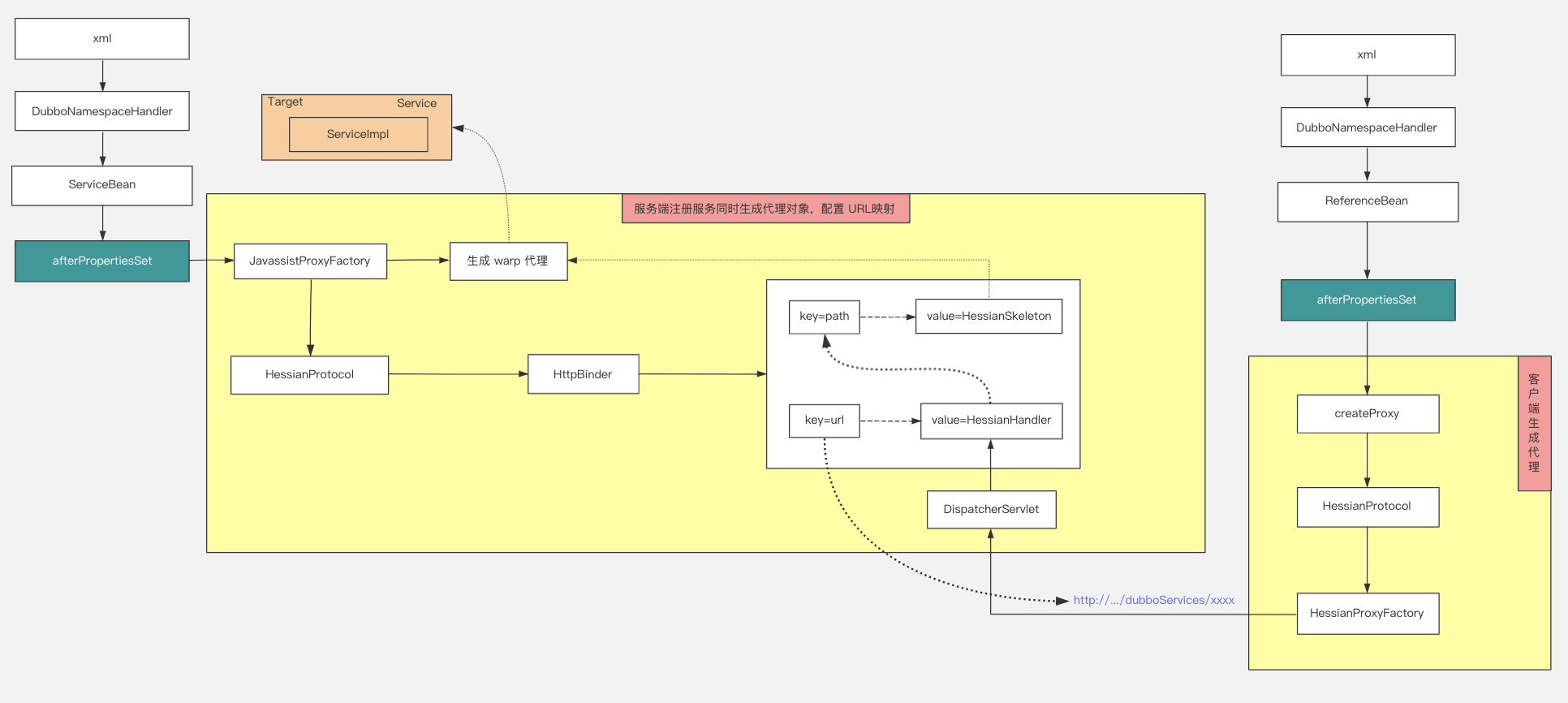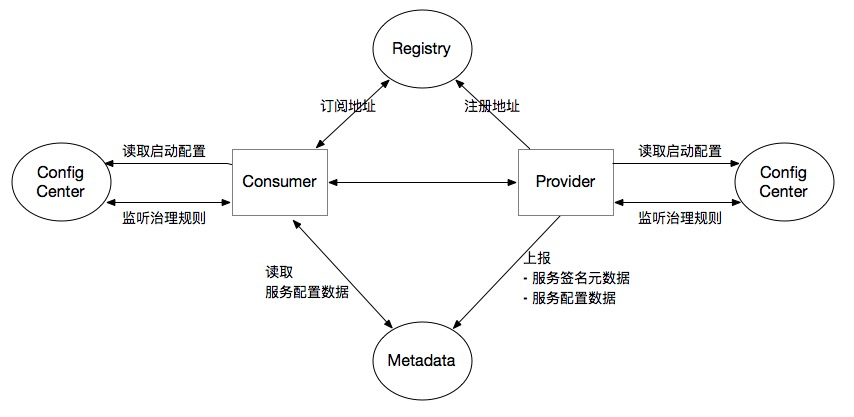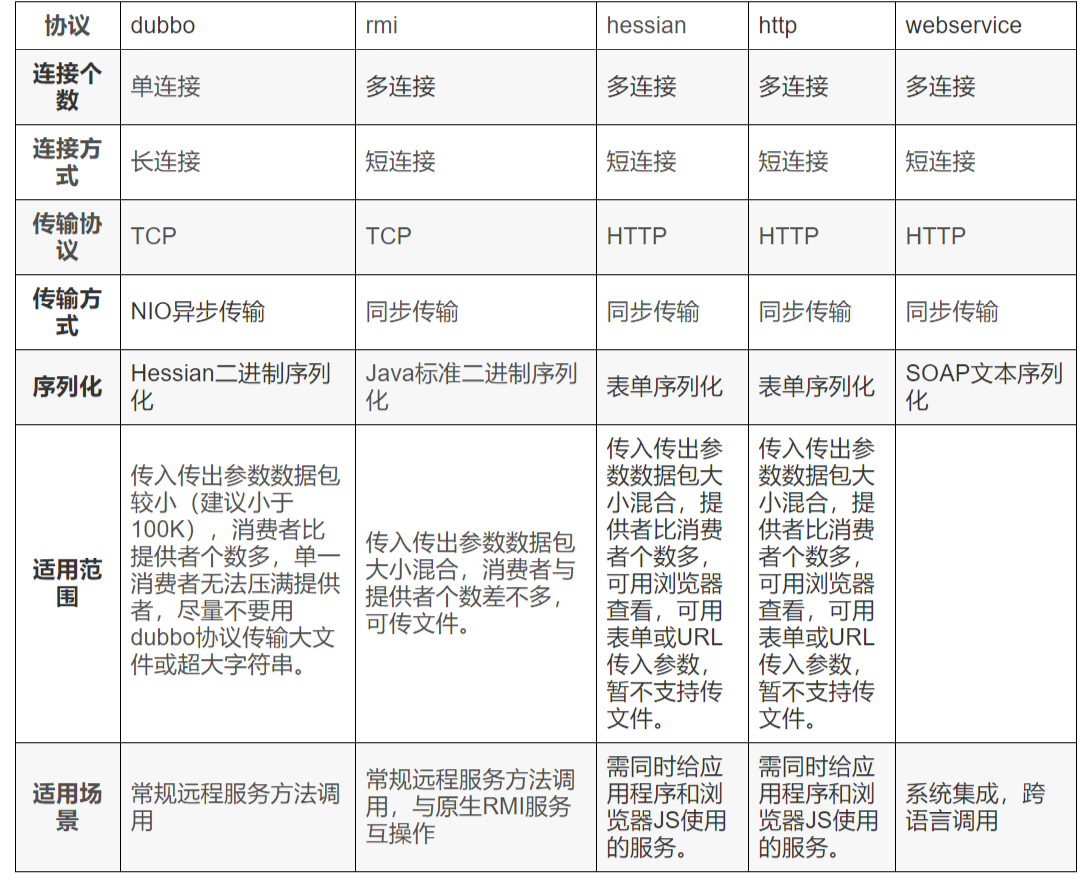1、介绍
Dubbo官方文档:https://dubbo.apache.org/zh
目前Dubbo最新的是Dubbo3。
Dubbo3 格式的 Provider 地址不能被 Dubbo2 的 Consumer 识别到,反之 Dubbo2 的消费者也不能订阅到 Dubbo3 Provider。
这里的架构和使用都是基于Dubbo2.7 版本,Dubbo2(2.7以下)和Dubbo3两个版本的注解有区别。

Registry是注册中心,用于发现服务者和消费者。
注册中心可以选择 zookeeper、consul、nacos,推荐使用zookeeper。
dubboRPC通信的原理:

2、架构
Dubbo三大组件:
- 注册中心。协调 Consumer 与 Provider 之间的地址注册与发现
- 配置中心。
- 存储 Dubbo 启动阶段的全局配置,保证配置的跨环境共享与全局一致性
- 负责服务治理规则(路由规则、动态配置等)的存储与推送。
- 元数据中心。
- 接收 Provider 上报的服务接口元数据,为 Admin 等控制台提供运维能力(如服务测试、接口文档等)
- 作为服务发现机制的补充,提供额外的接口/方法级别配置信息的同步能力,相当于注册中心的额外扩展

以上三个中心并不是运行 Dubbo 的必要条件,用户完全可以根据自身业务情况决定只启用其中一个或多个,以达到简化部署的目的。
通常情况下,所有用户都会以独立的注册中心 开始 Dubbo 服务开发,而配置中心、元数据中心则会在微服务演进的过程中逐步的按需被引入进来。
3、使用
依赖:(推荐使用2.7.13版本)
普通项目集成:
<dependency>
<groupId>org.apache.dubbo</groupId>
<artifactId>dubbo</artifactId>
<version>2.7.13</version>
</dependency>
<dependency>
<groupId>org.apache.dubbo</groupId>
<artifactId>dubbo-dependencies-zookeeper</artifactId>
<version>2.7.13</version>
</dependency>
springboot与dubbo集成:
<dependency>
<groupId>org.apache.dubbo</groupId>
<artifactId>dubbo-spring-boot-starter</artifactId>
<version>2.7.13</version>
</dependency>
<dependency>
<groupId>org.apache.dubbo</groupId>
<artifactId>dubbo-registry-zookeeper</artifactId>
<version>2.7.13</version>
</dependency>
3.1、spring.xml配置
1、服务端
在服务提供方实现接口(对服务消费方隐藏实现):
spring-provider.xml :
<!--注意:配置集群的情况下需要同一集群的name值相同-->
<dubbo:application name="demo-provider" />
<!-- 使用zookeeper注册中心暴露服务地址 -->
<dubbo:registry address="zookeeper://${zookeeper.address:127.0.0.1}:2181" />
<!--实际项目中使用properties文件的形式定义zookeeper的地址 -->
<!-- <dubbo:registry protocol="zookeeper" address="${zookeeper.address}" check="false" file="dubbo.properties" /> -->
<dubbo:provider token="true" />
<!-- beanId -->
<bean id="demoService" class="org.apache.dubbo.samples.basic.impl.DemoServiceImpl"/>
<!--用 Spring 配置声明暴露服务,ref="demoService" 是 beanId,必填 -->
<dubbo:service interface="org.apache.dubbo.samples.basic.api.DemoService" ref="demoService" />
<!--使用dubbo协议,声明服务的端口-->
<dubbo:protocol name="dubbo" port="20898"/>
一般来说,我们会把 beanId 交给 spring 去管理只需要在 xml 里面声明扫描包,然后使用 @Service 声明实现类 即可:
<context:component-scan base-package="org.apache.dubbo.samples.basic.impl"/>
2、客户端
spring-consumer.xml:
<dubbo:application name="demo-consumer"/>
<dubbo:registry address="zookeeper://${zookeeper.address:127.0.0.1}:2181"/>
<!-- 服务方引用的beanId -->
<dubbo:reference id="demoService" check="true" interface="org.apache.dubbo.samples.basic.api.DemoService"/>
3.2、springboot配置
1、服务端
上面例子的 spring-provider.xml 换成 properties 文件的写法是这样的:
# 应用名
dubbo.application.name=demo-provider
# 注册中心地址
dubbo.registry.address=zookeeper://localhost:2181
# 调用协议地址
dubbo.protocol.name=dubbo
dubbo.protocol.port=28080
#开启包扫描,可替代 @EnableDubbo 注解
#dubbo.scan.base-packages=com.meizui.quickgame
开启基于注解的dubbo功能(主要是包扫描@DubboComponentScan):
// 开启基于注解的dubbo功能(主要是包扫描@DubboComponentScan)
// 也可以在配置文件中使用dubbo.scan.base-package来替代@EnableDubbo
@EnableDubbo(scanBasePackages = {"com.meizui.quickgame"})
@SpringBootApplication
public class UserServiceProviderApplication {
public static void main(String[] args) {
SpringApplication.run(UserServiceProviderApplication.class, args);
}
}
2、客户端
# 应用名
dubbo.application.name=demo-consumer
# 注册中心地址
dubbo.registry.address=zookeeper://localhost:2181
dubbo.consumer.timeout=1000
使用例子1:
dubbo和spring可以完美结合,只需要在spring配置文件声明即可。
provider:
public static void main(String[] args) throws Exception {
ClassPathXmlApplicationContext context = new ClassPathXmlApplicationContext("spring/dubbo-demo-provider.xml");
context.start();
new CountDownLatch(1).await();
}
consumer:
public static void main(String[] args) throws IOException {
ClassPathXmlApplicationContext context = new ClassPathXmlApplicationContext("spring/dubbo-demo-consumer.xml");
context.start();
DemoService demoService = (DemoService) context.getBean("demoService");
String hello = demoService.sayHello("world");
}
使用例子2:
这里展示注解的方式,需要声明@EnableDubbo
provider:
@DubboService(version = "1.0.0")
public class UserServiceImpl implements UserService{
}
consumer:
@DubboReference(version = "*", protocol = "dubbo,hessian", loadbalance = "random" )
private UserService userService;
4、其他
4.1、负载均衡:
xml:
服务端级别:
<dubbo:service interface="org.apache.dubbo.samples.basic.api.DemoService" ref="demoService" loadbalance="roundrobin" timeout="5000"/>
服务端方法级别:
<dubbo:service interface="org.apache.dubbo.samples.basic.api.DemoService" ref="demoService" timeout="5000">
<dubbo:method name="sayHello" loadbalance="roundrobin"/>
</dubbo:service>
客户端级别:
<dubbo:reference id="demoService" check="true" interface="org.apache.dubbo.samples.basic.api.DemoService" loadbalance="roundrobin"/>
客户端方法级别:
<dubbo:reference id="demoService" check="true" interface="org.apache.dubbo.samples.basic.api.DemoService">
<dubbo:method name="sayHello" loadbalance="roundrobin"/>
</dubbo:reference>
当多个provider注册到zk,consumer会选择指定的负载均衡算法自动请求,遇到上线或者下线会重新计算。
常见有四种负载均衡:
- random
随机,按权重设置随机概率。
在一个截面上碰撞的概率高,但调用量越大分布越均匀,而且按概率使用权重后也比较均匀,有利于动态调整提供者权重。
- roundRobin (默认)
轮询,按公约后的权重设置轮询比率。
存在慢的提供者类即请求问题,比如:第二台机器很慢,但没挂,当请求调到第二台时就卡在那,久而久之,所有请求都卡在调到第二台上。
- leastActive
最少活跃调用数,相同活跃数的随机,活跃数指调用前后计数差。
使慢的提供者收到更少请求,因为越慢的提供者的调用前后计数差会越大。
- consistentHash
一致性Hash,相同参数的请求总是发到同一提供者。
当某一台提供者挂时,原本发往该提供者的请求,基于虚拟节点,平摊到其他提供者,不会引起剧烈变动
4.2多协议:
dubbo支持多种协议:
- dubbo
- hessian
- http
- rmi
- webservice
- thrift
- memcached
- redis
不同服务不同协议
不同服务在性能上适用不同协议进行传输,比如大数据用短连接协议,小数据大并发用长连接协议
<?xml version="1.0" encoding="UTF-8"?>
<beans xmlns="http://www.springframework.org/schema/beans"
xmlns:xsi="http://www.w3.org/2001/XMLSchema-instance"
xmlns:dubbo="http://dubbo.apache.org/schema/dubbo"
xsi:schemaLocation="http://www.springframework.org/schema/beans http://www.springframework.org/schema/beans/spring-beans-4.3.xsd http://dubbo.apache.org/schema/dubbo http://dubbo.apache.org/schema/dubbo/dubbo.xsd">
<dubbo:application name="world" />
<dubbo:registry id="registry" address="10.20.141.150:9090" username="admin" password="hello1234" />
<!-- 多协议配置 -->
<dubbo:protocol name="dubbo" port="20880" />
<dubbo:protocol name="rmi" port="1099" />
<!-- 使用dubbo协议暴露服务 -->
<dubbo:service interface="com.alibaba.hello.api.HelloService" version="1.0.0" ref="helloService" protocol="dubbo" />
<!-- 使用rmi协议暴露服务 -->
<dubbo:service interface="com.alibaba.hello.api.DemoService" version="1.0.0" ref="demoService" protocol="rmi" />
</beans>
多协议暴露服务
需要与 http 客户端相互操作
<?xml version="1.0" encoding="UTF-8"?>
<beans xmlns="http://www.springframework.org/schema/beans"
xmlns:xsi="http://www.w3.org/2001/XMLSchema-instance"
xmlns:dubbo="http://dubbo.apache.org/schema/dubbo"
xsi:schemaLocation="http://www.springframework.org/schema/beans http://www.springframework.org/schema/beans/spring-beans-4.3.xsd http://dubbo.apache.org/schema/dubbo http://dubbo.apache.org/schema/dubbo/dubbo.xsd">
<dubbo:application name="world" />
<dubbo:registry id="registry" address="10.20.141.150:9090" username="admin" password="hello1234" />
<!-- 多协议配置 -->
<dubbo:protocol name="dubbo" port="20880" />
<dubbo:protocol name="hessian" port="8080" />
<!-- 使用多个协议暴露服务 -->
<dubbo:service id="helloService" interface="com.alibaba.hello.api.HelloService" version="1.0.0" protocol="dubbo,hessian" />
</beans>
4.3、多注册中心
两个不同注册中心,使用竖号分隔多个不同注册中心地址:
<!-- 多注册中心配置,竖号分隔表示同时连接多个不同注册中心,同一注册中心的多个集群地址用逗号分隔 -->
<dubbo:registry address="10.20.141.150:9090|10.20.154.177:9010" />
<!-- 引用服务 -->
<dubbo:reference id="helloService" interface="com.alibaba.hello.api.HelloService" version="1.0.0" />
不同服务使用不同注册中心:
<!-- 多注册中心配置 -->
<dubbo:registry id="chinaRegistry" address="10.20.141.150:9090" />
<dubbo:registry id="intlRegistry" address="10.20.154.177:9010" default="false" />
<!-- 向中文站注册中心注册 -->
<dubbo:service interface="com.alibaba.hello.api.HelloService" version="1.0.0" ref="helloService" registry="chinaRegistry" />
<!-- 向国际站注册中心注册 -->
<dubbo:service interface="com.alibaba.hello.api.DemoService" version="1.0.0" ref="demoService" registry="intlRegistry" />
还可以这样:
<!-- 多注册中心配置 -->
<dubbo:registry id="chinaRegistry" address="10.20.141.150:9090" />
<dubbo:registry id="intlRegistry" address="10.20.154.177:9010" default="false" />
<!-- 引用中文站服务 -->
<dubbo:reference id="chinaHelloService" interface="com.alibaba.hello.api.HelloService" version="1.0.0" registry="chinaRegistry" />
<!-- 引用国际站站服务 -->
<dubbo:reference id="intlHelloService" interface="com.alibaba.hello.api.HelloService" version="1.0.0" registry="intlRegistry" />
4.4、超时、重试
超时默认重试 1000ms
重试默认重试2次,不算第一个调用,一共会调用三次
如服务方设置:
<dubbo:service interface="org.apache.dubbo.samples.basic.api.DemoService" ref="demoService2" loadbalance="roundrobin" timeout="500" retries="1"/>
注意,本人测试了一下,虽然服务方设置重试次数为1,消费者默认,最终结果还是会重试2次(消费者默认值),所以服务方提供的重试次数无效,建议在消费者设置,但是超时时间是生效的。
超时、重试建议在消费者设置:
<dubbo:reference id="demoService01" check="true" interface="org.apache.dubbo.samples.basic.api.DemoService"
retries="1" timeout="3000"/>
4.5、分组
当一个接口有多种实现时,可以用 group 区分。
provider.xml
<dubbo:service id="groupADubboService" group="groupA" interface="org.apache.dubbo.samples.group.api.GroupService"
ref="groupAService"/>
<dubbo:service id="groupBDubboService" group="groupB" interface="org.apache.dubbo.samples.group.api.GroupService"
ref="groupBService"/>
consumer.xml
<!-- * 表示 任意组-->
<dubbo:reference group="*" id="groupAService" check="false"
interface="org.apache.dubbo.samples.group.api.GroupService" />
<!-- 调用groupB接口 -->
<!--<dubbo:reference group="groupB" id="groupBService" check="false"-->
<!--interface="org.apache.dubbo.samples.group.api.GroupService"/>-->
group="*" 和 group="groupA,groupB" 是一样的效果,但总是只调一个可用组的实现。(不能实现负载均衡)
这里有个坑,reference group="*" ,consumer在启动的时候已经选好了分组,并不是轮询两个分组
如果你要使用group进行负载均衡,consumer就不要写group
4.6、版本
当一个接口实现,出现不兼容升级时,可以用版本号过渡,版本号不同的服务相互间不引用。
<dubbo:reference id="barService" interface="com.foo.BarService" version="1.0.0" />
<dubbo:service interface="com.foo.BarService" version="1.0.0" />
consumer 设置 version="*" 可以 轮询 调用provider,而group不能,这是和group的最大区别
4.6、直连模式
直连模式一般应用于测试模式。
消费者:
<dubbo:registry id="na" address="N/A" />
<!--使用直连的方式,不需要注册中心 这里的check表示开启token-->
<dubbo:reference id="demoService01" check="true" interface="org.apache.dubbo.samples.basic.api.DemoService"
url="dubbo://172.16.44.48:20897"
protocol="dubbo" registry="na"
timeout="3000"
retries="3"
/>
服务方不需要修改,如果开启了token验证,需要在<dubbo:provider> 或者 <dubbo:service>声明:
<dubbo:registry id="default" address="zookeeper://${zookeeper.address:127.0.0.1}:2181" />
<!--使用dubbo协议,声明服务的端口-->
<dubbo:protocol id="dubbo1" name="dubbo" port="20897" />
<dubbo:protocol id="dubbo2" name="dubbo" port="20898"/>
<dubbo:provider token="123456" registry="default">
<!--用 Spring 配置声明暴露服务 ref 的 值要等 beanId 的 值-->
<dubbo:service interface="org.apache.dubbo.samples.basic.api.DemoService" ref="demoService02" loadbalance="roundrobin"
timeout="5000" retries="1" protocol="dubbo1"/>
</dubbo:provider>
消费者需要携带token:
RpcContext.getContext().setAttachment("token","123456");
如果不需要token验证,设置成 false 即可
5、不同协议的区别
duboo3.0 的默认协议是 dubbo,较2.0版本来说是一个新的协议(官方称为triple)

| dubbo | rmi | hessian | http | webservice | thrift | |
|---|---|---|---|---|---|---|
| 传输协议 | TCP | TCP | HTTP | HTTP | HTTP | thrif |
| 传输方式 | NIO异步传输 | 同步 | 同步 | 同步 | 同步 | 同步、异步 |
| 序列化 | Hessian二进制序列化 | Java标准二进制序列化 | Hessian二进制序列化 | 表单序列化 | SOAP文本序列化 | Thrift |
| 适用范围 | 传入传出参数数据包较小(建议小于100K),消费者比提供者个数多,单一消费者无法压满提供者,尽量不要使用dubbo协议传输大文件或超大字符串 | 传入传出参数数据包大小混合,消费者与提供者个数差不多,可传文件。 | 传入传出参数数据包较大,提供者比消费者个数多,提供者压力较大,可传文件。 | 传入传出参数数据包大小混合,提供者比消费者个数多,可用浏览器查看,可用表单或URL传入参数,暂不支持传文件。 | 系统集成,跨语言调用。 | 跨语言 |
| 约束 | 参数及返回值需实现Serializable接口 | 参数及返回值需实现Serializable接口 | 参数及返回值需实现Serializable接口 | 不能在协议中传递null值 |
dubbo 有多种协议,不同的协议默认使用不同的序列化框架。比如:
dubbo 协议 默认使用 Hessian2 序列化。(说明:Hessian2 是阿里在 Hessian 基础上进行的二次开发,起名为Hessian2 )
rmi协议 默认为 java 原生序列化,
http 协议 默认为 为 json 。
hessian 协议,默认是 hessian 序列化;
webservice 协议,默认是 soap 文本序列化 。
6、注意事项(TODO )
1、使用了dubbo2.7.13 版本,thrift 协议 的name 是native-thrift,而且 RpcContext.getContext().getAttachments 无法获取参数
当前 dubbo 支持的 thrift 协议是对 thrift 原生协议 的扩展,与原生Thrift不兼容 ,使用的是
protocol="tri"吐槽一下,dubbo3官方的更新进度也太慢了,本人在使用dubbo 3.0.2.1 的时候,并没有 triple 协议,官方文档也没有找到demo,最后是在dubbo-benchmark项目才知道如何使用。
2、协议的支持
dubbo2.7使用默认的序列化协议是hessian,如果参数是泛型 ,返回值可能为null,此时可以修改序列化为 kryo,并加入:
<dependency>
<groupId>com.esotericsoftware</groupId>
<artifactId>kryo</artifactId>
</dependency>
<dependency>
<groupId>de.javakaffee</groupId>
<artifactId>kryo-serializers</artifactId>
</dependency>
3、版本的区别
目前dubbo 2.7 版本(包括2.7以下)建议使用dubbo作为RPC调用协议(也是默认)。
本人测试了一下,dubbo 3.0 版本情况下即使按照官方文档,引入 hessian 协议的依赖,仍然报:
No such extension org.apache.dubbo.rpc.Protocol by name hessian, no related exception was found, please check whether related SPI module is missing.
暂时没有找到解决方案。
使用dubbo 2.7.13 版本,是可以单独使用hessian协议的。
除此之外本人从网上+测试验证:
- dubbo3.0版本是2021年6月才出来的,新版本默认是使用 trilple 协议,还不兼容旧版本协议
- dubbo3.0官方并没有详细的使用文档,本人测试了一下,与2.7的兼容性还有很大问题,所以建议还是使用2.7版本
- dubbo更新太慢(3年都没有更新3.0版本,捐赠给Apache后基本无维护),网上找到的资料不如springcloud多
参考:
- 使用直连模式:https://blog.csdn.net/hcz666/article/details/115058048
- dubbo官方文档:https://dubbo.apache.org/zh























 705
705











 被折叠的 条评论
为什么被折叠?
被折叠的 条评论
为什么被折叠?










